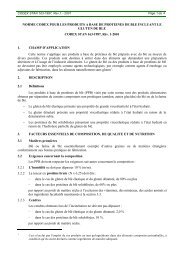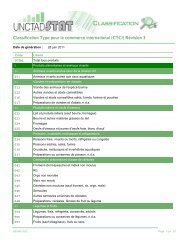issues and constraints related to the development of cashew nuts ...
issues and constraints related to the development of cashew nuts ...
issues and constraints related to the development of cashew nuts ...
You also want an ePaper? Increase the reach of your titles
YUMPU automatically turns print PDFs into web optimized ePapers that Google loves.
14Guinea Bissau. This is probably not specific <strong>to</strong> Guinea Bissau, but reflects <strong>the</strong> general fact that<strong>the</strong> smaller <strong>the</strong> nut, <strong>the</strong> higher <strong>the</strong> percentage out-turns. Côte d’IvoireThe germplasm collection <strong>of</strong> CNRA (Centre National de Recherche Agronomique) at Latahaconsisted <strong>of</strong> 36 trees, planted in one row in 1984, with a spacing <strong>of</strong> four meters between <strong>the</strong>m.The his<strong>to</strong>ry is that <strong>the</strong> seed for <strong>the</strong>se trees originated from one tree in Brazil <strong>and</strong> certainly <strong>the</strong>visual characteristics (size <strong>of</strong> nut <strong>and</strong> tree) would suggest that <strong>the</strong> trees did originate from ei<strong>the</strong>rone or more “Brazilian common” trees. These trees are very large, <strong>and</strong> with only four meters <strong>of</strong>spacing between <strong>the</strong>m, yield data cannot be very accurate, particularly as a potential indica<strong>to</strong>r forfur<strong>the</strong>r planting. With wider spacing <strong>and</strong> a full canopy, many <strong>of</strong> <strong>the</strong> trees would yield muchmore.Seed from some <strong>of</strong> <strong>the</strong> original germplasm collection was planted in 1997 in a new block <strong>of</strong> 45trees, at a spacing <strong>of</strong> 8m x 6m.No new <strong>cashew</strong> material has been introduced in<strong>to</strong> Cote d’Ivoire recently. Some time ago,however, seed from Brazil, presumably from large common trees, was imported <strong>and</strong> planted onan estate at Badikaha (near Korghogo). The SODIRO <strong>cashew</strong> plantation (100 ha) that wasplanted in 1993, used seed from this farm in Badikaha. Both sites would be good areas <strong>to</strong>evaluate <strong>the</strong> yield <strong>of</strong> a few visually good trees, for possible selection <strong>and</strong> trials.Since 1995, ANADER (Agence Nationale d’Appui au Développement Rural) has been selectingseed from visually good trees, on <strong>the</strong> basis <strong>of</strong> colour <strong>of</strong> apple, yield, tree structure <strong>and</strong> size <strong>of</strong> nut.The issue <strong>of</strong> planting material was very confused in people’s minds, <strong>and</strong> nothing is beingevaluated on farm <strong>and</strong> very little on station.A very informative visit was made <strong>to</strong> <strong>the</strong> farm <strong>of</strong> Mr Kone Koulouba, in Koro Ouleu village. Thefarmer started <strong>to</strong> plant an additional 4 ha <strong>of</strong> <strong>cashew</strong> in 1992, with assistance from ANADER.The seed for this block was all taken from one supposedly superior “selected mo<strong>the</strong>r tree” <strong>and</strong>, asis <strong>of</strong>ten <strong>the</strong> case, this selected tree was growing under ideal environmental conditions, namely:• isolated from o<strong>the</strong>r trees, hence canopy well developed <strong>to</strong> give good yield• open aspect• good access <strong>to</strong> sunlight• good access <strong>to</strong> soil nutrients <strong>and</strong> water• little competition.Whe<strong>the</strong>r this tree is in fact superior due <strong>to</strong> its ideal environmental position, or whe<strong>the</strong>r <strong>the</strong>re isany genetic basis for its above-average yield, can only be determined in a properly designed trialcomparing it with o<strong>the</strong>r good material. This is unfortunately a typical example <strong>of</strong> “mo<strong>the</strong>r tree”selection found in many countries. (NB “Selected mo<strong>the</strong>r tree” <strong>of</strong>ten means a local tree withsupposedly superior qualities such as yield or nut weight.)All germplasm material planted so far has been from seed; no vegetatively produced seedlingshave been used. Developing <strong>the</strong> technique <strong>of</strong> vegetative propagation was given high priority at ainternal stakeholder meeting held previously.


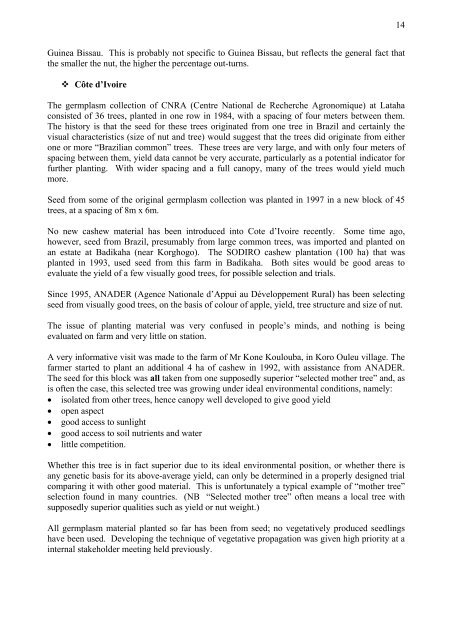
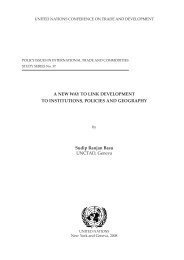
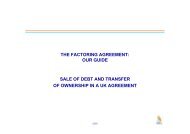
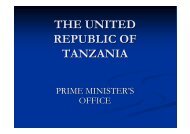
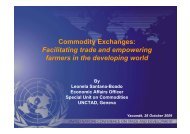
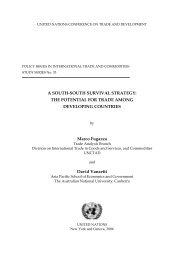
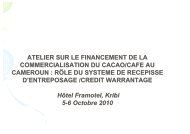
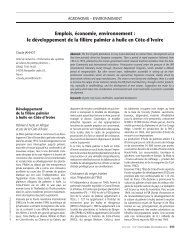
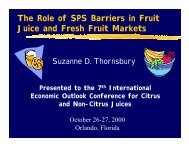
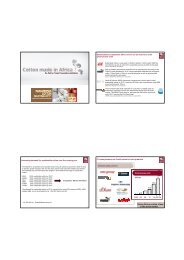
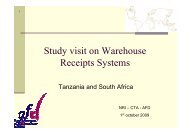
![Warehouse Receipt Systems: Legal Issues [PDF]](https://img.yumpu.com/43979338/1/190x134/warehouse-receipt-systems-legal-issues-pdf.jpg?quality=85)
